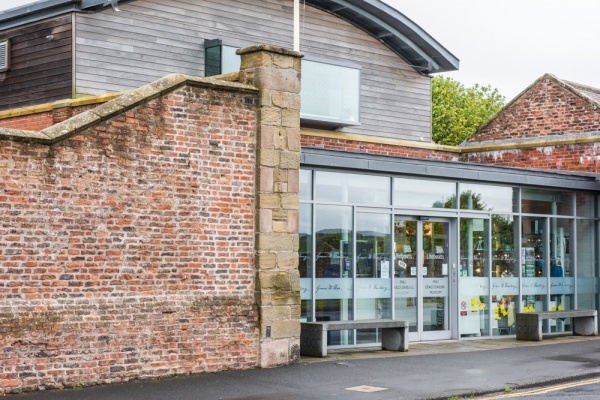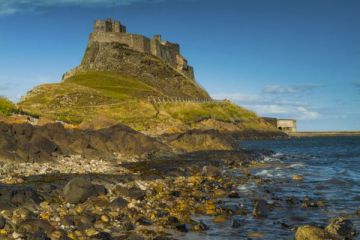
On 7 September 1838 fierce winds battered the Farne Islands, off Bamburgh, Northumberland. The Farne lighthouse keeper on that fateful night was William Darling, and when he realised that the SS Forfarshire had run aground in the heavy seas he and his daughter Grace, aged 22, set off in a rowboat to rescue the trapped sailors and passengers. Battling against the high seas, the pair managed to rescue nine of the sailors.
When news of the rescue spread, Grace Darling and her father became national heroes. Grace, in particular, was feted in the national press and became an incredibly popular celebrity. There was a thriving market in Grace Darling memorabilia and she was given gifts by nobility and royalty.
Tragically, Grace died just four years later of tuberculosis, prompting an outpouring of grief across the nation.

Grace Darling
Grace Horsley Darling was born in her grandfather's cottage in Bamburgh in 1815, the seventh of nine children and the fourth daughter born to William and Thomasin Darling. Willliam Darling was the lighthouse keeper at Brownsman Island, but in 1826, when Grace was 10 years old, the family moved to a new lighthouse at Longstone, the most distant of the Farne Islands.
The family lived in the lighthouse, built just 1m above the jagged rocks. It was a bleak and remote place to live, with no space for basics like a kitchen garden. The family of 11 people lived in one ground floor room, with bedrooms on the floors above.
In this remote location, Grace learned basic skills like sewing, knitting, spinning and cooking. William Darling made sure that all his children, boys and girls alike, were taught arithmetic, geography, and history in addition to reading and writing skills. The children also learned to help care for the lighthouse.
When she wasn't busy with her studies and housekeeping tasks Grace helped her father when he had to launch the lifeboat and she helped keep watch for ships in distress from the top of the lighthouse.

The Forfarshire Rescue
The steamship Forfarshire left Hull on 5 September 1838 bound for Dundee with a cargo of soap, cloth, spinning gear, boiler plate and hardware. She also carried paying passengers, with a combined 60 passengers and crew.
On 6 September the boiler began to leak. The captain attempted to steer to safety but he mistook the route in the storm. The engine stopped in the early hours of 7 September and the ship drifted onto Big Harcar Rock. Within a few minutes, the ship broke in two. The rear half was swept away in the storm, carrying 48 people to a watery grave.
Grace Darling spotted the ship in distress about 4:45 in the morning but it was only when dawn came at 7 am that she could see survivors clinging to Big Harcar Rock.
William Darling judged that the heavy seas would prevent the North Sunderland lifeboat from launching. The only chance to save the Forfarshire survivors was for William and Grace to row their 'coble' from Longstone to the wreck site.
William and Grace Darling rowed for an hour to reach the wreck site. There they found nine survivors on the rocks. The lifeboat could only hold five of them. William jumped onto the rocks, leaving Grace to keep the boat in place against the force of the waves.
Three of the male survivors helped William row back to Longstone with Grace, a female survivor, and an injured man. There Grace helped her mother care for the survivors while William and two of the men returned for the other survivors.

Aftermath
The story of the Forfarshire rescue and, more importantly, Grace Darling's role, was headline news across Britain. Grace became a national heroine and the public was eager for details of this young woman and her life. Artists travelled to the Longstone lighthouse to paint her portrait, and visitors thronged to meet her and her father. She was inundated with letters, many containing gifts.
William and Grace Darling were awarded silver medals by the National Institution for the Preservation of Life from Shipwreck (now the RNLI) and gold medals by the Royal Humane Society. News of Grace's deeds reached Buckingham Palace and Queen Victoria sent her 50 pounds, a huge sum at the time.
The life of a popular celebrity did not suit Grace. The onerous duty of writing replies to the steady stream of letters ate up her time and left little for her normal life.
In 1842, just four years after the Forfarshire disaster, Grace fell ill with tuberculosis and died shortly thereafter in Bamburgh. Her funeral drew huge crowds.
She was buried in St Aidan's churchyard under a simple headstone. Two years later an ornate memorial was erected on the burial site. A memorial stained glass window was installed in her honour. Several years later her effigy was moved inside the church to preserve it.

The RNLI Museum
Almost directly across the street from the church and memorial is a free museum dedicated to the life of Grace Darling and her family. Fittingly, the museum is operated by the RNLI (Royal National Lifeboat Institute), who carry on the same role as Grace and her father did that night in 1838.
The most important exhibit in the museum is the coble (lifeboat) in which William and Grace Darling rescued the crew of the SS Forfarshire. It is staggering to see just how small the lifeboat is and realise the strength and determination it must have taken to row the lifeboat across stormy seas and hold it in position to rescue the crew members of the Forfarshire.
The lifeboat is just one of the exhibits that make the museum so interesting.
Visitors can learn about Grace's early life and childhood, and her life in the remote lighthouse. See personal mementoes including private letters, family portraits, items of clothing, even the original headstone installed over Grace's grave before it was replaced with the present memorial.
One of the most intriguing exhibits is a scale model of the Longstone lighthouse where Grace and her family lived.
The museum has a free leaflet outlining sites around Bamburgh linked to the Darling family, including the house where Grace was born and the place she died. Her birthplace is just a few steps from the museum on Radcliffe Road.
On The Wynding is Wynding House, where the family moved after William Darling retired in 1860. Grace's older sister Thomasin cared for William in his final years and after his death she took in paying guests, many of them drawn by the story of Thomasin's younger sister.
On Front Street is the cottage in which Grace died. Further along Front Street is the Victoria Hotel, where the Forfarshire inquest was held four days after the ship ran aground. The owners and the ship's captain were found guilty of the willful death of 45 passengers.

About RNLI Grace Darling Museum
Address: Radcliffe Road,
Bamburgh,
Northumberland,
England, NE69 7AE
Attraction Type: Museum
Location: Opposite St Aidan's Church on Radcliffe Road.
Website: RNLI Grace Darling Museum
Location
map
OS: NU178348
Photo Credit: David Ross and Britain Express
POPULAR POSTS
HERITAGE
 We've 'tagged' this attraction information to help you find related historic attractions and learn more about major time periods mentioned.
We've 'tagged' this attraction information to help you find related historic attractions and learn more about major time periods mentioned.
Find other attractions tagged with:
NEARBY HISTORIC ATTRACTIONS
Heritage Rated from 1- 5 (low to exceptional) on historic interest
Bamburgh, St Aidan's Church - 0.1 miles (Historic Church) ![]()
Bamburgh Castle - 0.3 miles (Castle) ![]()
Farne Islands - 2.5 miles (Countryside) ![]()
Lindisfarne Castle - 5 miles (Castle) ![]()
Lindisfarne Priory - 5.4 miles (Abbey) ![]()
Preston Tower - 5.9 miles (Historic Building) ![]()
Lindisfarne - 6 miles (Countryside) ![]()
St Cuthbert's Cave - 7.3 miles (Countryside) ![]()
Nearest Holiday Cottages to RNLI Grace Darling Museum:
Bamburgh, Northumberland
Sleeps: 4
Stay from: £420 - 1455
More self catering near RNLI Grace Darling Museum











